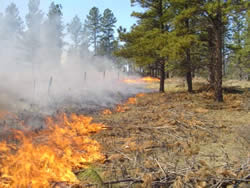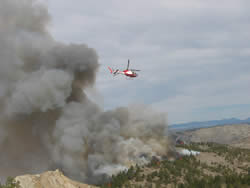
National Fire Plan Success Story
BLM Central Montana Fire/Fuels Program Ready to "Go Big"
Bureau of Land Management, Central Montana Fire Zone, Montana
National Fire Plan - Fuels Reduction
2009

Until recently many of the CMFZ's prescribed fire projects dealt with disposing of slash, much of which was not piled. These burns tend to be expensive, risky, and labor intensive.

Various ignition techniques will be utilized including aerial ignition as shown here in a similar 2005 landscape level project designed to improve habitat for bighorn sheep.
The BLM Central Montana Fire/Fuels Zone (CMFZ) has been busy preparing for what potentially could be a “big” spring burn season. According to CMFZ fuels specialist, John Seemann, “For the past couple of years, we've been pretty much focused on burning the activity fuels that we generated in the WUI. It will be nice to get out and do some larger landscape burning for a change.”
The transition from relatively small and expensive projects to larger landscape burning marks a significant milestone for the CMFZ fuels program. “We've made great strides over the past eight years towards reducing the threat of catastrophic fire to our high fire danger communities within the zone. Now we can put these areas into maintenance and spend more time out on the landscape protecting and improving our natural resources while hopefully making conditions safer for our firefighters this summer,” stated Jennifer Walker, fire ecologist for the CMFZ.
Of the 18 prescribed fire projects planned for 2009, three exceed 1,500 acres which is considered “relatively large when you're in the timber,” according to Walker. The goal of these projects is to improve the overall condition of the fire-adapted ecosystems that exist in central Montana. Specific objectives of the burns include reducing the threat of catastrophic fire by reducing the amount of surface and understory “ladder” fuels, improving wildlife habitat by stimulating shrub response and increasing forage production, and, in some cases, creating travel corridors to reduce predation of important big game species. Resource managers also hope to improve the health and distribution of the numerous “fire-starved” species that exist in central Montana.
In addition, these landscape-scale burns have generated much interest and assistance from several non-profit organizations and non-federal entities including the Rocky Mountain Elk Foundation, National Wild Turkey Federation, Montana Department of Natural Resources and Conservation, and others.
Stay tuned! An upcoming Snapshots article will let you know how the projects went.